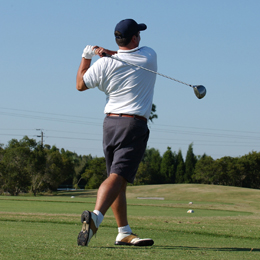|
www.GolfTrainingAid&TeachingTool.com Golf Swing Your golf swing will always be a work in progress. The world's best golfers even work on their golf swings. There is no perfection, only a little better than before. To get your golf swing a little better than it was before, here are six important tips to keep in mind. Pulled from expert sources far and wide, this golf swing information will help you swing better than before, and hopefully take a few strokes off your next round. (article continued below)
Proper Posture Makes Perfect: Correct posture, with knees slightly bent, back straight and hips tilted forward, enables you to swing consistently and efficiently. If your posture is off, your whole golf swing will suffer. To help yourself get into proper posture, you can hold a club against your back, touching the bottom or your spine and the back of your head (DiJulia). Then bend slightly forward at your hips, and unlock your knees while keeping the club against your spine and head. If you hold that posture and bring the club around to address the ball, now you are in proper golf-swing position (DiJulia). That is a great way to align your body before every golf swing until you can do it without the guide. A Still Head Equals Straighter Shots: The axis created by your head and spine guides the path and plane of your golf swing. When your head moves, your entire body and golf swing shifts, resulting in erratic shots. If you regularly miss hit the ball, it may be due to head movement. Use a mirror or have a friend watch to ensure you are keeping your head in position. Or, you could have someone help you the way Jack Nicklaus's coach helped him when he was younger. When you are in address position, have someone hold a lock of your hair, and if you move your head, you'll certainly know it (Mulvoy). However, using a mirror is much less painful. Let Your Arms Lead Your Downswing: If you cast your club head or lunge forward during your downswing, you might have a golf swing error referred to as coming over the top (Brewer). That problem usually occurs when you are too eager to start your downswing or trying to hit the ball too hard, and it results in a loss of distance and accuracy. To fix that golf swing error, PGA Professional Brad Brewer recommends focusing on completing a full shoulder turn and keeping your back to the ball as long as possible during your downswing. That will cause your club to follow your arms, resulting in a perfect, inside approach angle (Brewer). Unfreeze Your Lower Body for Full Rotation: The only way to maximize your power and control during a golf swing is to allow your lower body to move laterally. You must be able to turn your hips 45 degrees, with your belt buckle over your right knee (for right handed players). If your legs are frozen you won't be able to move, resulting in a reverse weight shift and an abbreviated backswing turn (Allen). Unfreezing your legs enables you to get a full range of motion and the proper timing required for a great golf swing. To Cure a Slice, Lead With the Toe: Slices result from hitting the ball with an open clubface (one facing away from your body). To train your body to make good contact, you must mentally overcompensate. Focus on rotating the toe of your club inward during your downswing, as if you were trying to have the toe of your club reach the ball before the heel. That will square the clubface sooner, eliminating your slice (Allen). Eventually with practice, the motion will feel natural, and your automatic golf swing will no longer result in a slice. Other Resources: Those tips are certainly only the beginning to improving your golf swing. If you would like more advice, tips and golf swing assistance, there are many golf instruction sources available. There are training aids, lessons, academies, videos, books, magazines and much more. For help sorting through the numerous options, check out these related articles: Training aids: Selecting the right golf training aid. Teaching tools: Matching your golf swing problem to a solution. Golf instruction: Finding the best way to improve your game. Golf lessons: The information you need to know before signing up. © Copyright 2006 www.GolfTrainingAid&TeachingTool.com |
